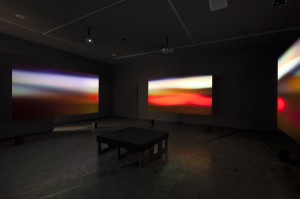Touching the surface: Angelica Mesiti
The vivid and the beautiful operate as an amnesty from the abundance of provisionality. But is it a satisfactory reprieve, say in relation to labour-intensive craftwork as another alternative? Specifically, I’m wondering how to find a space for ineffability in Mesiti’s work, beyond its surface—something problematic, a cleft where I can apply my own undirected interpretation. Metaphorically it’s the dead pixel I’m after. But I’m not looking for a fail, I’m trying to search out a space for interpretation where I don’t feel choreographed or coerced into an emotional response—this appears to be the irresistible propulsion of the work: the worthy subjects, their candid performances and Mesiti’s (high-definition) choices in aesthetic coercion.
There is a concentration on and of surface in this work, and as viewers we are in a vice: there doesn’t appear a way to relax into this seduction or reject it based on a slight-ness or a thin-ness, since the humanity runs thick. This is compulsive portraiture. And each performance, each coded gesture, communicates that paradox at the core of portraiture: that the outward appearance reveals the inner vast.
Big in production, projection size and quality, the four-channel video installation situates the viewer within an uncomfortable panopticon—like rote learning, constant refrains and universalist humanist themes. Like each subject we are rhythmically entranced. Where this video’s staging is more forceful than is required is within the interval between vignettes where the camera engages in an abstracted panning around the screens, an overladen metaphor for universalism perhaps.
Each performance is a performance observed. All is overt here, wedging us (the audience) in an emotional corner. Mesiti does a lot of hard work to make this look effortless. There is deep compassion and what appears to be a real fascination for her subjects is communicated and calculated. Novelist AS Byatt writes of the importance of invisible things in relation to portraiture, describing how even description in visual language of a face or a body may depend on being unseen for its force. In Mesiti’s video, each performer is lost in his or her own revelry, eyes closed in sincere engagement.
Angelica Mesiti, Citizen’s band, NEW12, Australian Centre for Contemporary Art, Melbourne, 17 March – 20 May 2012.



